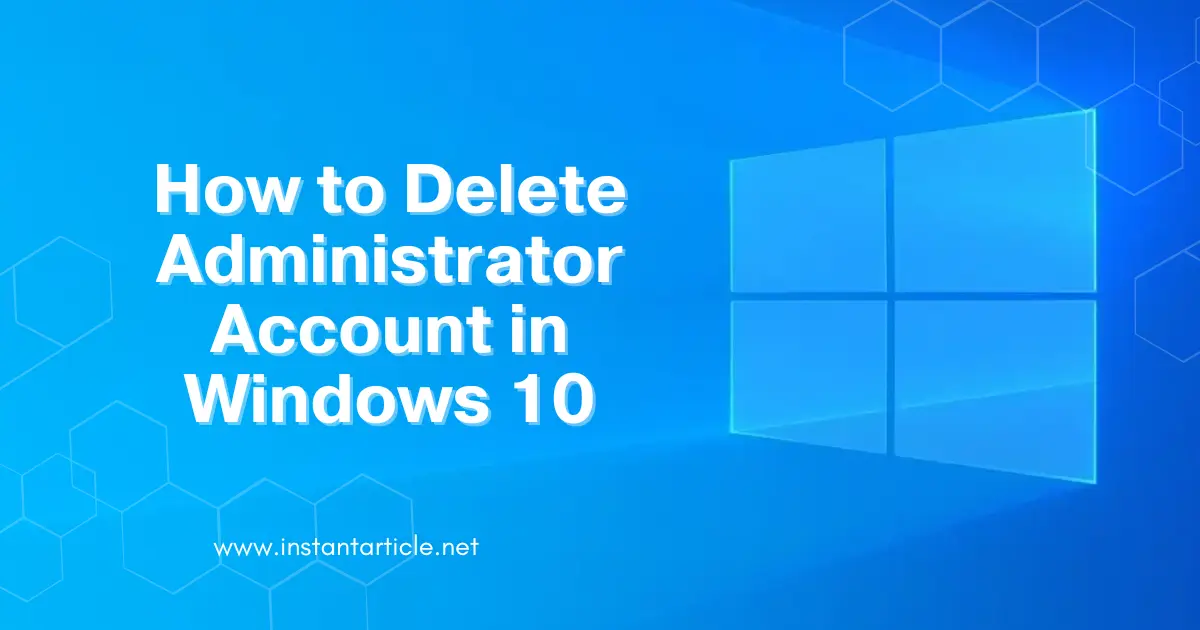Managing user accounts in Windows 10 is a crucial task, especially when it comes to removing an administrator account. Whether you’re cleaning up old accounts or securing your system, I’m going to guide you step-by-step on how to delete an administrator account in Windows 10 safely. You’ll also learn what happens when you do, and how to avoid common issues along the way.
Why Would You Want to Delete an Administrator Account?
If you’re like most users, there are probably a few good reasons to remove an extra administrator account:
- Security reasons: Extra admin accounts that aren’t in use could become a security risk.
- Simplification: Maybe you’re just trying to streamline your system.
- Reassignment: The previous user doesn’t need admin privileges anymore.
Before we jump into the steps, let’s make sure you’re ready to proceed.
What Happens If I Delete Administrator Account in Windows 10?
First things first: you need to understand what deleting an administrator account means for your system. Here’s what happens:
- Loss of all data for that account: All files in the account’s user folder (like downloads, desktop, and documents) are deleted. Be sure to back up anything you need.
- Loss of admin privileges: Once the account is gone, that user will no longer have administrative control over the system. Ensure there’s another administrator account active before deleting one.
- Shared resources might become inaccessible: If the admin account had access to shared files or printers, those settings might be affected.
Back Up Important Files Before Deleting
Before you delete an admin account, I recommend backing up all important files to an external hard drive or cloud service. You don’t want to lose any valuable data if it’s stored under that account.
How to Delete Administrator Account in Windows 10: Step-by-Step Guide
Let’s get into the steps. Here’s how you can delete an administrator account in Windows 10 safely:
Step 1: Log in to Another Administrator Account
You can’t delete the administrator account you’re currently logged into. So, if you haven’t already, log into a different account with admin privileges.
Tip: If you don’t have another administrator account, you’ll need to create one:
- Go to Settings > Accounts.
- Click Family & other users.
- Select Add someone else to this PC.
- Set up the new account and make it an Administrator.
Step 2: Open Settings
Once you’re in a different administrator account:
- Press Windows + I to open Settings.
- Click Accounts.
Step 3: Go to Family & Other Users
- In Accounts, select Family & other users from the menu on the left.
- Scroll down to the Other users section. Find the admin account you want to remove.
Step 4: Remove the Administrator Account
- Click on the account name and choose Remove.
- You’ll see a warning that says deleting this account will remove all its files. Make sure everything important is backed up.
- Click Delete account and data to confirm.
That’s it! The administrator account will be deleted, along with any files associated with it.
What to Do If You Can’t Delete the Administrator Account
Sometimes Windows won’t let you delete an administrator account, especially if it’s the only one on the system. If you run into this issue, here’s what you can try:
- Create another administrator account: As mentioned earlier, you need at least one admin account on the system to make major changes.
- Check account privileges: Make sure the account you’re trying to delete doesn’t have restrictions preventing its removal.
If these steps don’t work, you might need to use Safe Mode or Command Prompt to manually delete the account. However, I recommend sticking to the methods in this guide for safety and simplicity.
Alternative Method: Deleting an Administrator Account Using Control Panel
For users who prefer the old-school approach, you can delete the admin account using the Control Panel:
Step 1: Open Control Panel
- Press Windows + R to open the Run dialog.
- Type
control paneland hit Enter.
Step 2: Manage User Accounts
- In the Control Panel, go to User Accounts.
- Click Manage another account.
Step 3: Delete the Administrator Account
- Choose the administrator account you want to delete.
- Click Delete the account.
- When prompted, you can either Delete files or Keep files. Choose the option based on whether you need to retain the files.
Safeguarding Your System After Deleting an Administrator Account
After you delete the admin account, it’s important to make sure your system is still protected:
- Ensure another admin account is active: This is essential for managing system settings and software installations.
- Check shared resources: If the deleted account was handling shared files or printers, make sure to update permissions through the remaining admin account.
Frequently Asked Questions (FAQs)
No, Windows won’t let you delete the only administrator account. You need to have at least one active administrator account at all times.
Deleting an administrator account permanently removes all files associated with that account, including any personal documents, settings, and preferences. Always back up important files before deleting.
Once an admin account is deleted, you can’t recover it unless you have a backup of the account’s data. However, using file recovery software might help retrieve some files, though it’s not guaranteed.
To convert a standard user into an administrator:
1. Go to Settings > Accounts > Family & other users.
2. Select the user account and click Change account type.
3. Set the account type to Administrator.
Yes! You can disable an account temporarily without deleting it. Open Local Users and Groups by typing lusrmgr.msc into the Run box, and you can disable the account from there.

